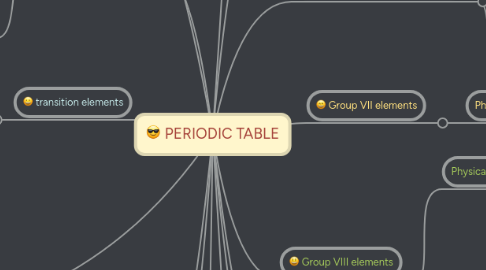
1. arranged in order of increasing proton number
2. groups(vertical columns)
2.1. no. of valence electrons is as the group number
3. Group O elements-noble gases
3.1. colourless gases at room temperature
3.2. low melting and boiling points
3.3. insoluble in water
3.4. have low melting and boiling points
3.5. monatomic
3.6. use to provide an inert atmostphere
3.6.1. eg. argon, neon,krypton
3.7. Full electronic structures
3.7.1. Inert - Prevents the noble gases from forming compounds readily
4. transition elements
4.1. High melting and boiling points
4.2. High densities
4.3. Between group II and III
4.4. Their valence electrons are present in more than one shell
4.4.1. Therefore exhibiting several common oxidation states.
4.5. Act as catalysts in a number of industrial processes
4.5.1. Have various electric charges
4.5.1.1. eg. Vanadium(V) or VA5+
4.6. Form coloured compounds
4.7. Ductile and malleable
4.8. Conduct electricity and heat
5. Group 1 elements (alkali metals)
5.1. Have low melting and boiling point
5.2. Have low densities. Lithium, sodium and potassium float on water
5.3. highly reactive
6. Uses of Noble gas
6.1. Helium- filling weather or advertisement ballons
6.2. Argon- fill tungsten bulbs
6.3. Neon- making lights and advertisement signs
6.4. Xenon- used in vehicle headlamps
6.5. Argon- also used to provide inert atmosphere
7. Roman numbers
7.1. 1st - I
7.2. 2nd - II
7.3. 3rd - III
7.4. 4th - IV
7.5. 5th - V
7.6. 6th - VI
7.7. 7th - VII
7.8. Last - 0
8. Metalloids
8.1. Found along the stair-step line that distinguishes metals from non-metals
8.1.1. Metals
8.1.2. Non-metals
8.1.3. Semi conductors
8.1.3.1. Silicon and germanium
9. Halogens
9.1. "Halogen" means "salt-former"
9.2. Compounds containing halogens are called "salts"
9.3. All halogens have 7 electrons in their outer shells
9.4. Exist in all three states of matter at room temperature
9.4.1. Solid- Iodine, Astatine
9.4.2. Liquid- Bromine
9.4.3. Gas- Fluorine, Chlorine
10. Group VIII elements
10.1. Physical Properties
10.1.1. Non-Metals
10.1.2. React with metals to form salt
10.1.3. Known as HALOGENS
10.1.4. Has 7 valance electron
10.2. chemical properties
10.2.1. React with a high tendency to attract one more electron to attain a stable octat configuration.
10.2.2. react with metals to form halides
10.2.2.1. Undergo displacement reactions, whereby the more reactive halogen displaces the less reactive halogen from its halide solution
10.3. Reactivity
10.3.1. The reactivity of halogens decreases down the group.
11. Group I elements (alkali metals)
11.1. Low melting and boiling point
11.1.1. Melting and boiling points decrease down the group
11.2. Physical Properties
11.2.1. Low density
11.2.1.1. Highly reactive with water
11.2.1.1.1. Must be stored in oil so that the alkali metals would not be in contact with the atmosphere as they are highly reactive with the water vapour in the atmosphere and tarnishes easily when left exposed to air
11.3. Soft and can be cut easily
11.3.1. Silvery and shiny when freshly cut
12. Group VII elements
12.1. Physical Properties
12.1.1. Non-Metals
12.1.1.1. Iodine
12.1.1.1.1. Bromine
12.1.2. Form coloured compounds
13. Feature of periodic table
13.1. Groups
13.1.1. a vertical column of elements
13.1.2. number of valence electrons is the same as group number
13.1.2.1. charge of ion is related to group number
13.1.3. charge of ion is related to group number
13.2. Period
13.2.1. Number of electron shells is the same as period number
13.2.2. a horizontal row
14. Period(horizontal rows)
14.1. Elements change from metal to non-metal from the left-hand side to right-hand side
15. Non-metals
15.1. Not able to conduct electricity or heat very well
15.2. Very brittle
15.2.1. Cannot be rolled into wires or pounded into sheets
15.3. Exist in two of the three states of matter at room temperature
15.3.1. Gases
15.3.2. Solid

